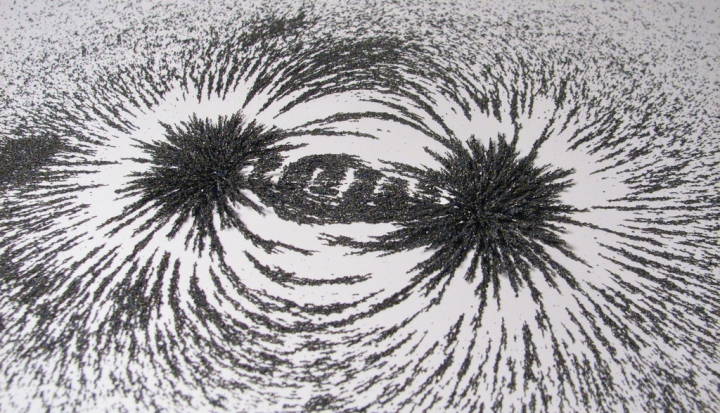I came to faith because of magnets.
I was raised in a family that found no conflict between faith and science. It was only when I was older that I learned that there was one, at least in the minds of some. Rather, both science and the Christian faith were deeply venerated, with my father being both a Presbyterian Elder and a proverbial rocket scientist. When I was quite young, he ordered some magnets from a catalog as a birthday gift for me. And when they arrived, we went to the basement, put some nails in a vise, got a file out of a drawer, and began making a little pile of iron filings. He showed me how to place a magnet on a white sheet of paper, and sprinkle the filings around it to produce the classic pattern. Although I didn’t know yet about electromagnetic (E-M) fields, and certainly couldn’t articulate what I was thinking and feeling as I played, looking back I realize it was my conversion experience.
There is a wonder to it that still arrests me to this day. My childish mind grappled with something that I now know to be rather deep, but I was too naïve to be intimidated. Instead, I wondered! My dad taught me the basics of a magnetic field, but even then the wondering was ageless and eternal. How is it that there exists something completely massless, invisible, spatially boundless, and of indescribable power, operating in and through this simple magnet from a catalog? How is it that the field is somehow the very essence of that little piece of mass? How is it that the field is linked to every atom in the universe, as well as to every photon? And then one day, I was introduced to electric fields, the E part of the E-M field, and then to gravity, and the wondering continued.
Later I was taught how to calculate the strength of the gravitational field between the earth and the moon. The equation was straightforward, but I couldn’t get past the notion that this was just a shortcut to make the math easier. What was really going on was that every single proton, every neutron, every little piece of the earth, my body included, was extending its tiny little gravity field, vanishingly weak, a quarter-million miles out into space then to interact with every single particle comprising the moon. All the equation did was to add it all up elegantly.
My scientific wondering preceded my spiritual wondering. So when I learned that human beings have a spirit, that we aren’t just a body, it made sense. I already knew that the physical part of the magnet was secondary, indeed trivial, and its essence was the field. This felt right to me. The spirit of people was really their essence, and their bodies were what was secondary and rather trivial.
“God is spirit, and those who worship him must worship in spirit and truth” (John 4:24). Before, I had been wading safely near shore; now, I couldn’t touch bottom anymore. That inner essence of a human being, and even the inner essence of an atom or a photon, is somehow linked to God—the overarching and deeply infusing essence of all.
When we speak of God, we are virtually forced to use metaphors. We speak of God the Father or Mother, the Rock of our salvation, the Lamb of God. Even when we use the word spirit, it is still metaphorical, meaning breath or wind. So have we stumbled upon a metaphor for our age, an age dominated by science and technology? Is God the field? I can’t easily dismiss the idea because I remember what fields are—massless, invisible, spatially boundless, and of indescribable power.
But please notice something technical here. Nobody really knows what fields are. All I did was to list several adjectives. We don’t really have a clue about what fields are in any ontological sense. They exist. We can measure and chart their presence and strength, but we have no idea what they are. And it isn’t a coincidence that the same thing can be said of divinity.
I don’t know if field is a metaphor or reality. But I’m grateful that the wonder I experienced as a child dropping iron filings around the perimeter of my magnet has not abated. I now live my days with a conviction, much like an operating system functioning in the background, that the invisible is the truer reality. Not to denigrate the physical world, which plays its part, but the physical world is the veneer, not the underlying structure. It is a veil which only partially obscures a magnificent essence.
It is that conviction which continuously links to the other profound ideas I find in scripture. When Paul says that the human being is a temple, I can only conclude that the massless, invisible, spatially boundless, and indescribably powerful essence we call God dwells within. After that, every little particle of matter becomes an example, a visual aid, indeed, a sacrament. When Jesus reminds the disciples that the kingdom of God is within them, using the rare emphatic word entos for within, what are we to think? As soon as I try to wrap my head around such an idea, the brain goes to overload immediately. The kingdom of God is within each and every one of us—how can I wrap my mind around that?
And speaking of wrapping our head around something, there is that enigmatic phrase buried in the Book of Ecclesiastes. Right after the part about how there is a time for everything under the sun, and for everything there is a season, the author then states, “…he has put a sense of past and future (olam) into their minds (nephesh), yet so that they cannot find out what God has done from the beginning to the end” (Ecclesiastes 3:11). Olam is the ancient Hebrew concept for what we would now call Einsteinian space-time. That is, the universe, the cosmos, the whole shebang. And nephesh is the inner essence, our soul. God has placed olam into our nephesh; of course we have trouble wrapping our logical mind around something so boggling. But this is where Paul and Jesus were coming from. And this is why so many of the mystics throughout the ages were rapt in awe when they peered into such magnificence; they understood a bit more clearly than the rest of us.
Carl Sagan once wrote, “Science is not only compatible with spirituality; it is a profound source of spirituality.” That has certainly been the case for me. And the blessing is that this can be seen wherever I look. I can look into the night sky and imagine the Hubble Deep Field, or examine a fossil and ponder deep time. I can watch a bee within a flower, a seed sprouting, or even muse over the processor in my phone. My favorites are still fields—magnetic, electric, gravitational. It is still amazing to me to be at the beach and watch the coordination between the moon and the tides, each silently linked to each other. The world has become sacramental to me; every part of the natural world points to God’s presence.
But I will always hold a special place in my heart for magnets.
Image: Flickr cc via Wendell Oskay














Add comment